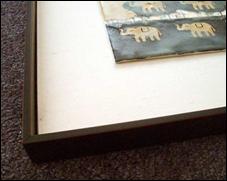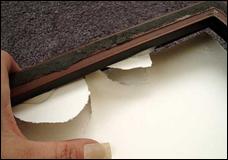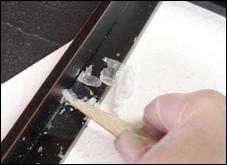 Photo 1
Photo 1
Encaustic panel glued to linen backing
The art in the photo had been mounted to the linen with clear silicone adhesive—which held it very well—however silicone is known to seep oils over time and shall never be used in conjunction with any original art. In order to remove this art from the linen the back layer of rag paper had to be torn from the board.
Even though tearing any layer of the 8-ply rag is not advised practice, in this case the removal of the silicone from the back of the art by removing that silicone saturated layer will most likely save it from future damage. There are many types of adhesive solvent on the market, and all are caustic to touch and breathe. Acetone is a familiar solvent, as well as naphtha, xylene, and toluene, all of which are available at Home Depot.
 Photo 1
Photo 1
Encaustic panel glued to linen backing
 Photo 2
Photo 2
Torn paper backing left attached to frame
Just as it did with the art, the silicone held the linen backing to the frame very well, but all framing should be removable for future care of any original art. When the glued backing was torn from the frame without any solvent the silicone tears leaving large chunks of backing board stuck to the frame. Is is no solvent for silicone—NO SOLVENT. By saturating the dried silicone with solvent slightly and after five to ten minutes a fairly blunt bamboo scraper was used to get under the globs of adhesive and scrape it off the frame.
 Photo 3
Photo 3
Dried silicone being scraped to clean
So why is it acceptable to use wood glue in framing and not silicone? Silicone is a very aggressive adhesive it is not suited to use in framing. It outgases which can contaminate and leave a haze on the inside of the glass of a sealed frame package and its petroleum based oils will seep out over time saturating whatever is in contact with—including paper, board and wood. All in all, not a good adhesive around art. If it must be the adhesive of choice use only acid free, electrical grade silicone (GP Nutralcure CL 2.8oz Silicone Sealant & Adhesive) available online, but not found in home improvement and regular hardware stores. Never any silicone adhesive with paper of any kind, only an occasional object project where silicone may have already been previously used as the adhesive and has coated the item backing preventing it from setting with another adhesive.
END
Copyright © 2011 Chris A Paschke
For more articles on mounting basics look under the mounting section in Articles by Subject.
Additional information on all types of mounting is found in:
The Mounting and Laminating Handbook, Second Edition, 2002,
The Mounting And Laminating Handbook, Third Edition, 2008 and
Creative Mounting, Wrapping, And Laminating, 2000 will teach you everything you need to know about getting the most from your dry mount equipment and materials as an innovative frame designer.
All books are available from Designs Ink Publishing through this website.
Chris A Paschke, CPF GCF
Designs Ink
Designs Ink Publishing
785 Tucker Road, Suite G-183
Tehachapi, CA 93561
P 661-821-2188
chris@designsinkart.com